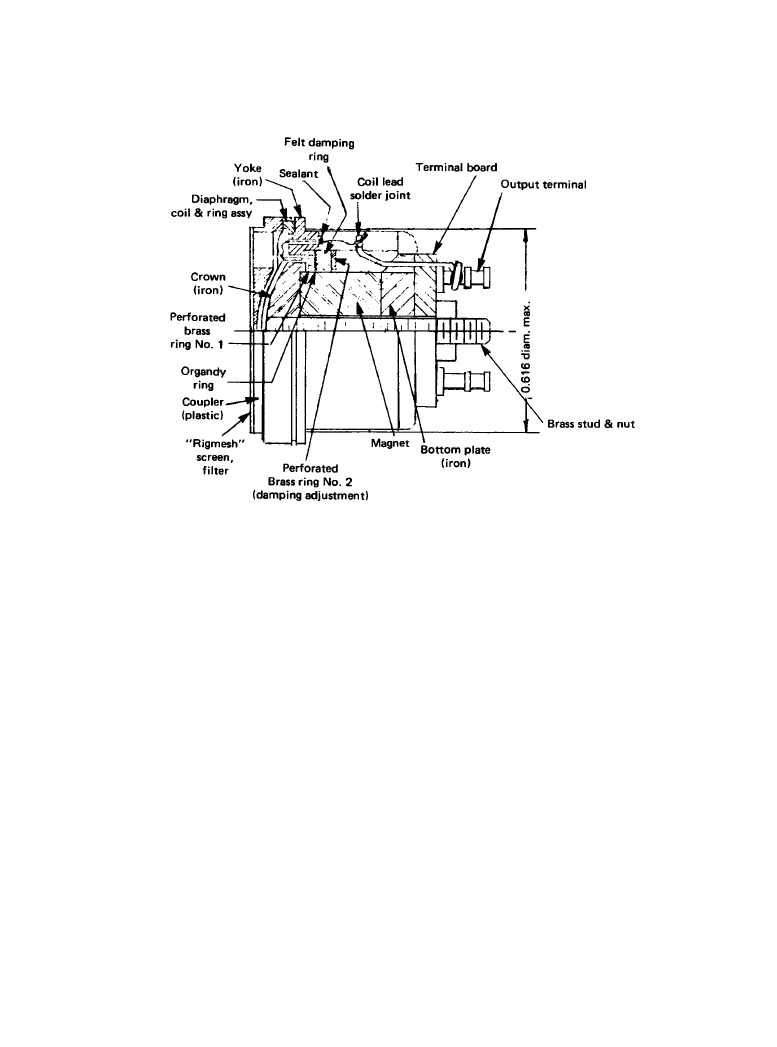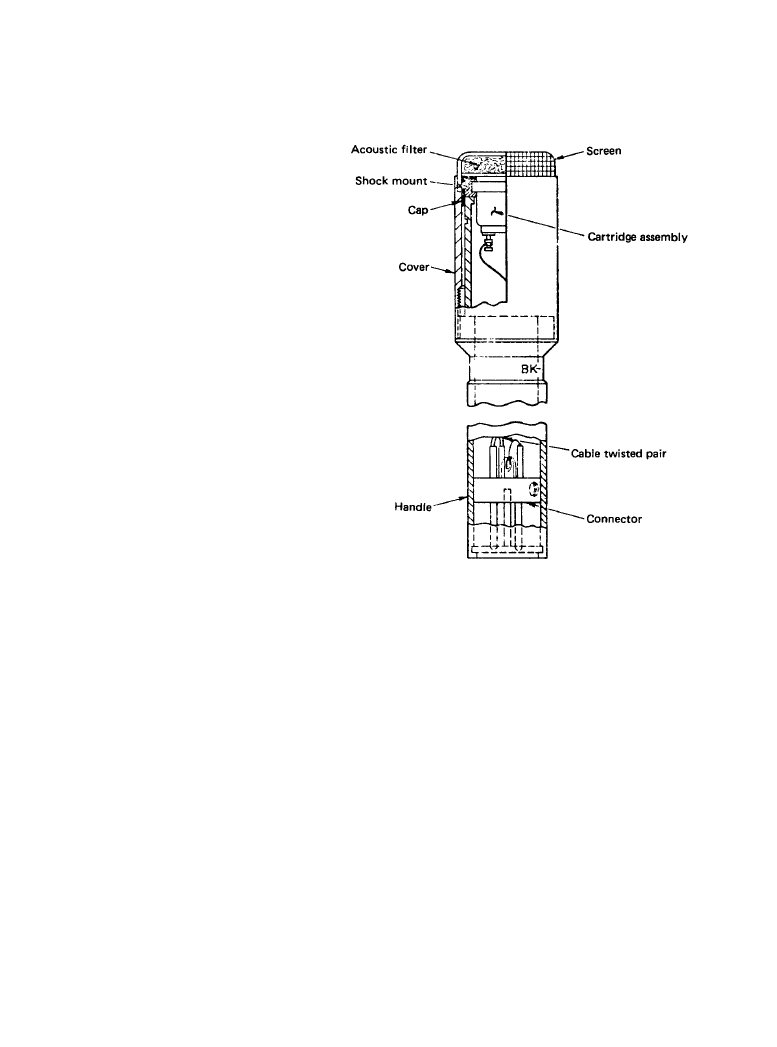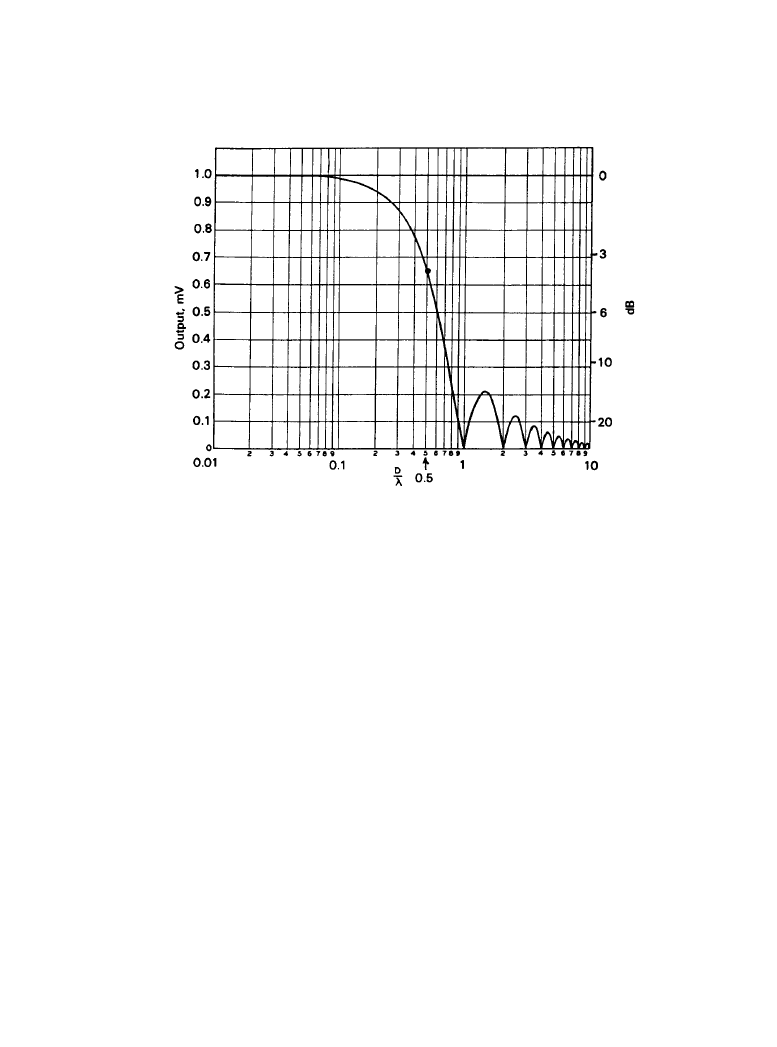ВУЗ: Казахская Национальная Академия Искусств им. Т. Жургенова
Категория: Книга
Дисциплина: Не указана
Добавлен: 03.02.2019
Просмотров: 21631
Скачиваний: 19

Microphones 4-15
suffers from dips in frequency response at the frequency where the spacing is one-quarter wave-
length and its harmonics, as the reflected sound wave interferes with the direct sound wave.
When the spacing is reduced to about 0.04 in (1 mm), the null frequency moves far above the
audible range. Therefore, in actual use the boundary microphone does not suffer from the comb-
filter series of dips in frequency response. The system has, in essence, a directional gain of 6 dB
due to pressure doubling at the reflecting plane; for example, the reflected wave is in phase and
adds to the amplitude of the direct wave. This results in a hemispheric pickup pattern where the
90° response (direction parallel to the plane) is 6 dB down with respect to the 0° or perpendicular
incidence response.
4.1.2e
Electrodynamic Microphones
A cross section of a moving-coil-microphone cartridge is shown in Figure 4.1.9, and the com-
plete microphone assembly in Figure 4.1.10 [9]. The diaphragm, which is made of Mylar polyes-
ter film 0.00035 in (9
µm) thick, is glued to a voice coil, which moves in the magnetic air gap.
The flux density is 10,000 G (1 Wb/m
2
). The self-supporting coil is wound with four layers of
no. 50 AWG copper wire, which results in a dc resistance of 220
Ω. The ac impedance of 200 to
250
Ω is suitable for standard low-impedance microphone inputs of 150 to 600 Ω. Older micro-
phone coils were on the order of 5- to 20-
Ω resistance and required a step-up matching trans-
former in the microphone case. Thus the modern moving-coil microphone will drive standard
Figure 4.1.9
Dynamic moving-coil pressure-microphone cartridge.
Downloaded from Digital Engineering Library @ McGraw-Hill (www.digitalengineeringlibrary.com)
Copyright © 2004 The McGraw-Hill Companies. All rights reserved.
Any use is subject to the Terms of Use as given at the website.
Microphones

4-16 Microphone Devices and Systems
bipolar integrated circuits directly. The coupler (Figure 4.1.9) fits closely to the diaphragm to
provide mechanical protection without frequency discrimination. The cartridge is shock-
mounted in the case of Figure 4.1.10, which includes a foam filter screen for dirt and breath
“pop” protection.
The voltage induced in the voice coil is given by
(4.1.5)
Where:
E = open-circuit voltage, V
B = air-gap flux density, Wb/m
2
l = length of conductor in air gap, m
= velocity of coil, m/s
This shows that the microphone will have uniform E with respect to frequency if the coil
velocity is uniform with frequency. The mechanical resonance of the coil and diaphragm (mea-
sured in a vacuum) is about 800 Hz. If the resonance is not well damped, the coil velocity will
peak at 800 Hz. This resonance is heavily damped by the acoustic resistance of the felt damping
ring so that the resulting response is uniform from 40 to 20,000 Hz. The coil motion is then said
to be resistance-controlled. The case volume is sufficient to support this extended low-frequency
E
Blx·
=
x·
Figure 4.1.10
Dynamic moving-coil
microphone.
Downloaded from Digital Engineering Library @ McGraw-Hill (www.digitalengineeringlibrary.com)
Copyright © 2004 The McGraw-Hill Companies. All rights reserved.
Any use is subject to the Terms of Use as given at the website.
Microphones

Microphones 4-17
response. In older microphones, it was necessary to add a vent tube inside the case, possibly as
long as 4 in (10 cm). This provided a form of bass-reflex action in which the mass of the air in
the tube resonated with the compliance of the air in the case.
4.1.3
Pressure-Gradient (Velocity) Microphones
A sectional view of a classic ribbon velocity microphone (RCA type BK-11A) is shown in Fig-
ure 4.1.11. This microphone has an air gap 0.125 in (3.2 mm) wide with a flux density of 6500 G
(0.65 Wb/m
2
). The ribbon is made of pure aluminum foil weighing 0.56 mg/cm
2
. This corre-
sponds to a thickness of 0.000082 in (2
µm). The ribbon is 1.4 in (36 mm) long and corrugated
transversely, as shown. Magnetic fine-mesh steel screens are on both sides of the ribbon to pro-
vide resistance damping of the ribbon and dirt protection. The ribbon resonance is approximately
30 Hz. The ribbon is soldered to the clamp after assembly and tuning. Soldering has no effect on
tuning when done properly. Without soldering, in several years microphone impedance may rise
and eventually result in an open circuit at the ribbon. The 0.2-
Ω ribbon impedance is stepped up
to 30/150/250
Ω by the transformer. The reactor and switch provide low-frequency rolloff for the
proximity effect. The frequency response is + 2 dB, 30 to 15,000 Hz.
The elements of the complete equivalent mechanical circuit (Figure 4.1.11) are R
L
and M
L
,
the mechanical resistance and mass of the air load on the ribbon, imposed by the damping
screens; M
R
and C
R
, the mass and compliance of the ribbon, and M
S
and R
S
, the mass and
mechanical resistance of the slits formed by the ribbon to pole-piece clearance, which is nomi-
nally 0.005 in (125
µm). Above resonance, the circuit is simplified as shown, and the ribbon
velocity is given by
(4.1.6)
Where:
= ribbon velocity, m/s
= difference in sound pressure (pressure gradient) between two sides of ribbon, N/m
2
A
R
= area of ribbon, m
2
M
R
= mass of ribbon, kg
M
L
= mass of air load acting on ribbon, kg
ω = 2πf
f = frequency, Hz
The driving sound pressure gradient (P
1
– P
2
) at a given frequency is proportional to the size
of the baffle formed by the magnet structure. The ribbon-to-polepiece clearance forms a leak
which, if excessive, will reduce sensitivity. To maintain a constant ribbon velocity with mass
control per Equation (4.1.6), the pressure gradient must increase linearly with frequency. The
open-circuit ribbon voltage is given by
(4.1.7)
x·
P
1
P
2
–
(
)A
R
j
ω M
R
M
L
+
(
)
--------------------------------
=
x·
P
1
(
P
2
)
–
E
Blx·
=
Downloaded from Digital Engineering Library @ McGraw-Hill (www.digitalengineeringlibrary.com)
Copyright © 2004 The McGraw-Hill Companies. All rights reserved.
Any use is subject to the Terms of Use as given at the website.
Microphones

4-18 Microphone Devices and Systems
Where:
E = open-circuit voltage, V
B = air-gap flux density, Wb/m
2
l = length of ribbon, m
= ribbon velocity, m/s
At zero frequency the pressure gradient is zero. At the frequency where the path length
around the baffle, from the front to back of the ribbon, corresponds to one-half of the sound
x·
Figure 4.1.11
Classic ribbon velocity microphone (RCA type BK-11A) and mechanical networks.
Downloaded from Digital Engineering Library @ McGraw-Hill (www.digitalengineeringlibrary.com)
Copyright © 2004 The McGraw-Hill Companies. All rights reserved.
Any use is subject to the Terms of Use as given at the website.
Microphones

Microphones 4-19
wavelength, the pressure gradient departs from a linear characteristic to 65 percent of the value
needed for a constant ribbon velocity. At the frequency where the path length equals one wave-
length, the pressure gradient is zero. Figure 4.1.12 shows the resulting E versus frequency for an
ideal microphone, applicable to the region well above ribbon resonance. A practical microphone
may have small ripples in response in the region just above resonance frequency, plus dips or
peaks at high frequencies due to pole-piece shape or transverse resonances of the ribbon.
Figure 4.1.13 shows how the figure-of-eight polar pattern becomes severely distorted above
the half-wavelength frequency (D equals the path length). Below this frequency, the patterns are
essentially perfect cosines.
A compromise solution is found in the contemporary ribbon velocity microphone. The head
diameter is typically on the order of 1.5 in (38 mm). The magnetic assembly is extremely small
but efficient. The two ribbons are electrically in parallel and make use of most of the space and
magnetic flux available in the air gap. They are usually corrugated longitudinally for most of
their length, but a few conventional transverse corrugations may be formed near the ends to pro-
vide compliance. This type of ribbon, while difficult to make, can potentially solve several prob-
lems as compared with the conventional ribbons with transverse corrugations:
•
The rigid central portion resists twisting, sagging, and scraping along the pole pieces.
•
With the more rigid ribbon, the pole-piece-to-ribbon clearance may be reduced, thus increas-
ing sensitivity.
Figure 4.1.12
Computed open-circuit voltage response frequency characteristic of a pressure-
gradient mass-controlled electrodynamic microphone. (
From [10]. Used with permission.)
Downloaded from Digital Engineering Library @ McGraw-Hill (www.digitalengineeringlibrary.com)
Copyright © 2004 The McGraw-Hill Companies. All rights reserved.
Any use is subject to the Terms of Use as given at the website.
Microphones